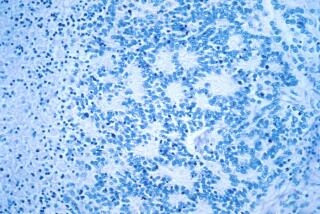S.D. Scientists Hold High Hopes for New Gene Therapy Method
- Share via
San Diego scientists announced Friday a new method of gene therapy that they say will prove cheaper and more practical than techniques now used in the cutting-edge field.
“We wanted a technique that was more practical and that could be generally applied to more cancers. And we found one,” said Dr. Robert E. Sobol of the San Diego Regional Cancer Center. “The result is a more generally applicable method of gene therapy.”
With the new technique, researchers employ skin cells to act as messengers that will stimulate the body’s immune system, prompting it to ward off cancer cells.
Sobol, who works with Dr. Ivor Royston, scientific director of the cancer center, presented the team’s findings Friday at the third annual meeting of the American Assn. for Cancer Research.
In gene therapy, a field so new it was a mere notion 20 years ago, scientists are still attempting to translate the promise of ideas to actual medications that can treat patients with deadly diseases.
With gene therapy, scientists hope to one day edit the body’s genetic code, stifling harmful genes and promoting useful ones. While traditional medications treat the symptoms of disease, gene therapy attempts to target the actual causes.
Until now, gene therapy scientists have relied on genetically engineered tumor cells to stimulate the body, prompting the immune system’s attack. But the cancer cells, Sobol said, have proven difficult to grow and to genetically manipulate. Cells for lung, breast and colon cancers have long thwarted scientists’ efforts to grow them outside the body.
By contrast, the skin cells--or fibroblast--are readily obtainable, grow without difficulty in cultures, and can be easily manipulated genetically, Sobol said. “We felt it had definite advantages.”
To make these cells useful in battling cancer, scientists modify them genetically so they secrete cytokines, or substances that stimulate the immune system. Sobol and his group are working specifically with the cytokine called interleukin-2.
In a preliminary study of mice, data showed that 60% of mice tested with this new gene therapy were protected against colo-rectal cancer, while all those in the unprotected control group got tumors.
“With gene therapy, by taking genetically modified fibroblast, we were able to significantly enhance anti-tumor activity,” Sobol said.
In the group of mice treated with the new method of gene therapy, most warded off cancer. And, among those 40% that got cancer, the tumors were smaller than their counterparts in the control group.
More important, Sobol believes the method is not limited to a particular type of cancer.
“The approach we developed is more generally applicable to different types of cancer than the other methods,” he said.
Last fall, federal officials asked Sobol, Royston and their colleagues to conduct more experiments when the team asked for permission to begin using the therapy on human patients.
In the months ahead, scientists will continue to investigate gene therapy, seeking to ensure that it’s safe. Armed with the new data, including the study presented Friday, the team will probably return to federal officials, asking once again for permission.
Because of the unique nature of the therapy, the team will need permission from two federal authorities: the Recombinant DNA Advisory Committee with the National Institutes of Health, and the Food and Drug Administration.
Sobol and the others believe they will be able to treat human patients by early next year. The study would be limited to cancer patients for whom other treatments have failed or there is no treatment.






